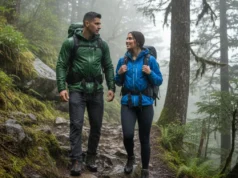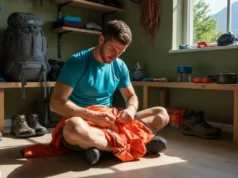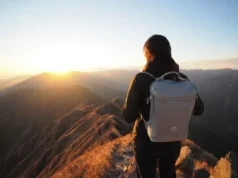In this article
Standing at the trailhead, the promise of adventure is thrilling, but the gear aisle can be intimidating. With price tags soaring, many beginners wonder if outdoor recreation is an accessible hobby. The good news? It is. This guide for hiking for beginners on a budget is the result of our commercial investigation into the best budget hiking gear. It will show you that building a kit of affordable hiking equipment isn’t a compromise; it’s a masterclass in making smart, durable choices and developing the very skills that make a competent hiker. This is more than a simple listicle of options; we’ll teach you to see gear not as equipment, but as a set of tools for building confidence and competence on the trail. You’ll learn the expert’s framework for balancing Price, Weight, and Durability, discover why tough gear is a beginner’s best friend, and master the art of strategic spending. Finally, we’ll provide a curated product listicle with personal testing notes for two distinct day hiking vs. backpacking setups, helping you distinguish between essential vs. specialized gear.
How to Choose the Right Budget Hiking Gear: An Expert’s Framework
To make a smart, confident choice that moves beyond price tags, you need to understand the true, long-term value of your gear. This section provides a complete how-to guide with beginner-focused recommendations to arm you with the objective knowledge needed when you’re in the consideration stage, helping you build a reliable kit from scratch.
Why is the ‘Iron Triangle’ (Cost, Weight, Performance) Your Most Important Tool?
Every piece of hiking gear you consider exists within a constant tug-of-war between three fundamental attributes: its Price, its Weight on your back, and its Durability and performance. This is the “Iron Triangle,” and its unbreakable rule is that you can typically optimize for two of these attributes, but the third will always be a compromise. A low-cost, lightweight item is rarely durable. A durable, low-cost sleeping bag with a warm temperature rating (verified by the EN rating system) is rarely lightweight. This isn’t a limitation; it’s a strategic lens for avoiding the need to buy twice, embracing the “buy once cry once” philosophy. The art of budget hiking is about consciously choosing which compromises make the most sense for your goals and skill level. By understanding this foundational gear philosophy, you connect this strategic triangle to the practical reality of building a complete kit based on the 10 Essentials system.
Why Should Durability Be Your Top Priority on a Budget?
Now that you understand the trade-offs in the ultralight vs. durable options debate, let’s focus on the single most important attribute for a beginner’s long-term success: durability. When you’re just starting, your gear will inevitably be scraped against rocks, stuffed hastily into a pack, and used in ways you haven’t yet learned to avoid. Budget-friendly, robust fabrics like 68-denier polyester are built for this learning curve. They forgive mistakes in a way that specialized, featherweight materials like Dyneema—found in premium gear like the Zpacks 20F Solo Quilt and requiring careful handling—simply cannot. For a novice, added durability extends the functional life of the gear, representing a superior long-term investment. A $179 pack that lasts a decade provides far greater value than a $120 pack that fails after two seasons. We must reframe durability not as a weight penalty, but as a key feature that maximizes your return on a limited budget. This approach stands in contrast to the principles of ultralight backpacking, which prioritize shaving grams above all else—a philosophy best adopted after you’ve mastered the fundamentals outlined by foundational systems like the Leave No Trace 7 Principles.
Where Should You Strategically Invest vs. Save?
Embracing durability helps you build a solid foundation, and the next step is allocating your limited funds to the right places with these money-saving hacks. Smart spending means investing in items that directly impact your safety and comfort. Footwear is the single most important investment you’ll make; the wrong budget hiking boots can ruin a hike and cause painful injuries. Paired with this are quality Merino wool socks from proven brands like Darn Tough, specifically the Darn Tough Hiker Micro Crew Cushion Socks—a “pricey but worth it” investment for moisture management and blister prevention. Finally, a quality backpack with a proper suspension system and trampoline back for ventilation is essential for carrying weight comfortably over long distances.
Conversely, there are many areas to find thrift options and save significantly. Start with moisture-wicking clothing you already own; there’s no need to buy expensive hiking attire right away, as long as you avoid cotton. An effective rain jacket like the Frogg Toggs can be had for under $50. You can also assemble your own mini first aid kit with a multi-tool for a fraction of the cost of pre-made ones. Lastly, build your trail menu from grocery store items and reuse a Nalgene water bottle instead of buying a fancy hydration bladder. This framework connects the skill of saving on clothing to the critical practice of building a proper layering system with affordable, functional pieces.
Our Selection Process: How We Built This Guide
To build absolute trust, it’s important we transparently detail our rigorous research and curation process. Our commitment is to objectivity. We aren’t here to create simple product roundups; our mission is to empower you with knowledge and recommend trail tested products that offer the best long-term value for beginners. Every product in this guide was judged against the critical attributes we just discussed: the balance of Cost, Weight, and Performance, with a special emphasis on Durability as a key value feature for new hikers. Our process began with a deep analysis of the gear landscape, identifying items consistently praised for their reliability and accessibility. We then curated these selections into logical kits for the most common beginner personas—the Day Explorer and the Aspiring Backpacker.
Pro-Tip: Before you buy anything, take an inventory of what you already own. Athletic t-shirts (polyester or nylon), a school backpack, and reusable water bottles are often perfectly suitable for your first few day hikes, allowing you to save your initial budget for a truly critical item like footwear.
A quick note on affiliate links: If you choose to purchase through our links, we may earn a small commission at no extra cost to you. This supports our work, but our recommendations are driven by our commitment to your success on the trail, not by brand partnerships.
The Best Budget Hiking Gear of 2025: Our Top Recommendations for Every Need
Here, we present our curated top recommendations for the key user personas, applying the principles we’ve established. We’ve done the research so you can spend less time shopping on e-commerce sites and more time building skills on the trail.
Our Top Picks for The Day Explorer
These items are perfect for day hiking trips on local trails, prioritizing safety, comfort, and a low initial investment. This foundational emergency kit will get you out the door and build your confidence for bigger adventures to come. Paired with a solid daypack like the Osprey Hikelite 26, these selections are designed to be lightweight, packable, and offer maximum versatility for a new hiker.
Our Top Picks for The Aspiring Backpacker
Ready to spend a night under the stars? This backpacking gear kit forms the “Core Four” (emergency shelter, sleeping system, backpack) plus a stove, providing a complete and durable system for overnight trips without breaking the bank. Each piece is chosen for its balance of durability, user-friendliness, and outstanding value, considering key attributes like R-Value and temperature rating to ensure comfort at designated campsites during a best season trip.
Pro-Tip: Your first few overnight trips should be “backyard backpacking” or at a drive-up campsite. This allows you to test your entire system—pitching your tent, cooking a meal, checking sleeping bag warmth—with the safety and comfort of your car nearby in case something goes wrong or you forget a critical item.
Conclusion
Building a budget hiking gear kit is an exercise in strategic decision-making, not just finding the lowest price. This focus on gear for skill building is key to a holistic hiker education. As we’ve explored, prioritizing durability in your backpack and tent provides the best long-term value and withstands the inevitable learning process. A smart budget allocates more funds to critical comfort and safety items like footwear and a quality pack, while saving on things like clothing and DIY kits. Ultimately, the most effective hiking kit is not the most expensive gear, but the one that is understood, practiced with, and thoughtfully assembled after careful research and planning. Now that you have the framework and the gear recommendations, the only thing left to do is start your adventure. Begin with what you have, make one smart purchase at a time, and embrace the journey of becoming a skilled, confident, and budget-conscious hiker. Happy trails!
Frequently Asked Questions about Budget Hiking Gear
Can I start hiking with gear I already own?
Yes, absolutely; for day hiking, many people can start with items like athletic apparel, running shoes, and a school backpack they already own. The goal is to lower the barrier to entry, and using used gear is the best way to start before you invest in a specialized 25L pack like the REI Co-op Flash 22.
What are the most important items to spend money on first?
The consensus among experienced hikers is to first invest in quality footwear, socks, and a well-fitting backpack. Our footwear reviews consistently show these items have the biggest impact on your comfort and safety on the trail, while you can easily save money on things like clothing, food, and basic rain gear.
Is ultralight gear a good option for a beginner on a budget?
While there is a growing budget ultralight path with options like the Lanshan 1P Tent, traditional budget gear is often more durable and better suited for beginners. Ultralight backpacking gear can be less forgiving and require more careful handling, whereas robust gear like the REI Trailmade 60 Pack is built to withstand the rigors of learning and the occasional mistake.
For a beginner’s backpack, what’s more important: features or fit?
Fit is, without question, the most critical factor in a backpack’s performance. An improperly fitted pack will be uncomfortable regardless of its price, capacity, or features like deep side pockets, causing sore shoulders and an aching back. Measuring your torso length to find a pack that matches your body is a non-negotiable first step to comfortable hiking.
Risk Disclaimer: Hiking, trekking, backpacking, and all related outdoor activities involve inherent risks which may result in serious injury, illness, or death. The information provided on The Hiking Tribe is for educational and informational purposes only. While we strive for accuracy, information on trails, gear, techniques, and safety is not a substitute for your own best judgment and thorough preparation. Trail conditions, weather, and other environmental factors change rapidly and may differ from what is described on this site. Always check with official sources like park services for the most current alerts and conditions. Never undertake a hike beyond your abilities and always be prepared for the unexpected. By using this website, you agree that you are solely responsible for your own safety. Any reliance you place on our content is strictly at your own risk, and you assume all liability for your actions and decisions in the outdoors. The Hiking Tribe and its authors will not be held liable for any injury, damage, or loss sustained in connection with the use of the information herein.
Affiliate Disclosure: We are a participant in the Amazon Services LLC Associates Program, an affiliate advertising program designed to provide a means for us to earn advertising fees by advertising and linking to Amazon.com. As an Amazon Associate, we earn from qualifying purchases. We also participate in other affiliate programs and may receive a commission on products purchased through our links, at no extra cost to you. Additional terms are found in the terms of service.





